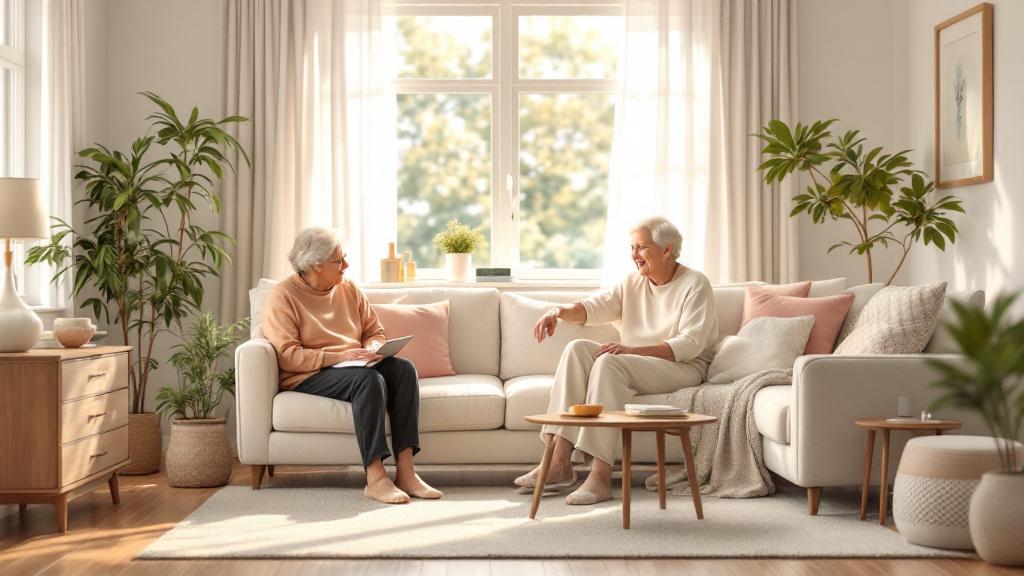The Importance of Balance and Coordination Training in Home Therapy
Harnessing Home Therapy: Transforming Lives through Balance and Coordination

Understanding Balance and Coordination Training
Balance and coordination underpin our ability to move confidently through our daily routines, yet they often go unnoticed until they become compromised. Home therapy focusing on these elements offers a practical approach to maintaining independence and enhancing quality of life. By integrating exercises into a home routine, individuals can effectively lower the risk of falls and improve their physical function, particularly as they age.
The Significance of Balance in Everyday Life

What is the importance of balance and coordination?
Balance and coordination are vital for performing everyday activities safely and efficiently. Good balance helps to prevent falls and injuries, especially for older adults, where falls can lead to serious health concerns. Maintaining balance is crucial as it directly relates to physical health, supporting actions like walking, bending, and climbing stairs.
The body's ability to balance relies on the coordinated functions of sensory systems such as vision, proprioception, and the vestibular system located in the inner ear. As we age, factors like inner ear problems, neurological conditions, muscle weakness, and certain medications can adversely affect these systems, leading to a decline in balance. This can create difficulties in daily tasks, reduce confidence in physical abilities, and increase the risk of falls, particularly among older adults.
Regular balance exercises not only improve muscle strength and stability but also counteract the effects of a sedentary lifestyle, enhancing overall physical function. By engaging in focused balance training, individuals can recover more quickly from injuries and help prevent future accidents, thus improving quality of life.
| Factor Affecting Balance | Description | Impact on Quality of Life |
|---|---|---|
| Aging | Natural declines in muscle mass and joint mobility | Increased fall risk |
| Inner ear dysfunction | Issues with vestibular system affecting balance | Higher chances of falls |
| Musculoskeletal conditions | Weakness impacting stability | Reduced mobility and independence |
| Medications | Side effects that impair coordination | Increased danger of falls |
Engaging in balance and coordination exercises can significantly enhance one’s quality of life by improving mobility, strength, and overall confidence in daily activities.
Exercises That Transform Home Environments into Training Grounds

What are some exercises to improve balance and coordination at home?
To improve balance and coordination at home, several effective exercises can be incorporated into your routine. Here’s a list of some basic yet impactful exercises you can try:
Standing on One Foot
- Stand on one leg while holding onto a support if necessary.
- Aim to hold the position for 10 to 30 seconds before switching legs.
Heel-to-Toe Walking
- Walk in a straight line by placing the heel of one foot directly in front of the toes of the other foot.
- Repeat this until you reach a set distance, like 10 feet.
Weight Shifts
- Start with your feet hip-width apart.
- Shift your weight to one side while lifting the opposite foot, holding for up to 30 seconds. Switch sides and repeat.
Tandem Standing
- Stand with one foot directly in front of the other in a straight line.
- Hold this position for as long as possible, aiming for at least 30 seconds.
Sit-to-Stand
- From a seated position, stand up and sit back down repeatedly.
- This helps to strengthen leg muscles, crucial for balance.
Incorporating these exercises into a weekly regimen of at least twice a week can lead to significant improvements in balance and coordination.
Key exercise techniques for balance improvement
In addition to the basic exercises, focusing on specific techniques can enhance the effectiveness of your training. Here are some key techniques:
Progressive Challenges: Start with easier variations like balancing with support and gradually eliminate supports as you gain confidence.
Dynamic Elements: Incorporate movements such as walking sideways (Simple Grapevine) or lunges to enhance stability under motion.
Use of Supports: When practicing balance, utilize sturdy furniture or walls for initial support to ensure safety.
This structured approach to balance training can transform your home into an effective training ground, empowering you to maintain and improve your balance and coordination as you age.
Physical Therapy's Pivotal Role in Balance Rehabilitation

How can physical therapy help in addressing balance issues?
Physical therapy addresses balance issues through tailored exercise programs focused on improving strength, stability, and coordination, particularly in older adults. These specially designed balance exercises encompass static and dynamic activities that enhance postural control, helping to significantly lower the risk of falls and related injuries.
Regular participation is advised at least two to three times a week to maximize these benefits. Research has shown that this structured approach not only improves physical confidence but also positively impacts cognitive functions such as memory and spatial awareness, thus elevating overall quality of life.
Examples of exercises and their benefits
Specific exercises recommended in physical therapy for balance rehabilitation include:
| Exercise | Description | Benefits |
|---|---|---|
| Single-Leg Stand | Balancing on one leg while holding furniture for support to build stability. | Enhances leg strength and proprioception. |
| Heel-to-Toe Walk | Walking in a straight line, heel to toe, to challenge balance and coordination. | Improves gait, balance speed, and control. |
| Tai Chi | Gentle movements performed in a flowing manner, emphasizing control and stability. | Reduces fear of falling and enhances calm. |
| Sit-to-Stand Exercise | Transitioning from sitting to standing to fortify leg muscles essential for mobility. | Boosts functional leg strength, vital for daily activities. |
Incorporating such exercises into home therapy routines yields substantial progress in balance and coordination, allowing individuals, especially seniors, to move with increased confidence and safety in their daily lives.
Long-Term Gains in Balance and Coordination

How can balance and coordination training improve quality of life for older adults?
Balance and coordination training can significantly enhance the quality of life for older adults by improving their physical stability and reducing the risk of falls. Engaging in exercises that challenge balance, such as standing on one foot or performing dynamic movements, strengthens muscles critical for maintaining an upright position.
Regular practice not only improves muscle strength but also promotes better mobility and independence. This is vital for navigating daily tasks, reducing the fear of falling, and supporting overall confidence in physical abilities.
Another benefit is the enhancement in cognitive functions. Studies show that these exercise programs can lead to improved memory and spatial awareness, fostering a greater sense of well-being.
To ensure safety and effectiveness, a structured program that includes progressive challenges, as well as warming up and cooling down, is essential. Such programs allow older adults to gradually enhance their balance and coordination, placing them in a better position to engage actively in day-to-day activities, thus contributing positively to their quality of life.
Long-term effects of balance training
The long-term effects of balance training are profound. Studies indicate that consistent practice can lead to:
| Benefit | Description | Impact on Daily Life |
|---|---|---|
| Improved reaction time | Faster responses during potential falls or loss of balance | Reduces fear and enhances confidence |
| Better coordination | Enhanced ability to perform complex movements | Aids in daily activities like walking |
| Stronger flexibility | Increased muscle elasticity protects joints from injuries | Facilitates movement and mobility |
| Enhanced cognitive health | Better assessment and response to fall risks | Promotes independent living |
| Improved posture and core strength | Reduces the risk of tripping and falling during activities | Boosts overall stability |
Over time, these benefits coalesce to significantly reduce fall risks, showcasing the value of balance training in maintaining independence among older adults. Consistently implementing such exercises at home can create a safer living environment and elevate overall well-being.
Adaptive Balance Training Methods for All Ages

What methods of balance training are suitable for various age groups?
Balance training incorporates a variety of techniques that cater to the unique needs of different age groups. For older adults, specific exercises can enhance stability and reduce the risk of falls. These include:
- Standing on One Leg: This exercise helps improve unilateral stability and leg strength.
- Weight Shifts: Shifting weight from one leg to another promotes balance and proprioception.
- Tai Chi: Known for its gentle movements, Tai Chi enhances coordination and flexibility.
Younger individuals, including children, can engage in fun and interactive activities to develop their balance skills. Activities suitable for them are:
- Bean Bag Balance: Balancing a bean bag on the head promotes core strength and focus.
- Heel-to-Toe Walking: This fun activity encourages body awareness and coordination.
Athletes often benefit from dynamic exercises that challenge their balance, coordination, and stability, such as:
- Single-Leg Cross-Body Punches: This involves engaging the core while balancing on one leg, enhancing both strength and coordination.
- Banded Toe Taps: Utilizing resistance bands can further improve stability and strength during movement.
Regardless of age, it's essential to practice balance exercises at least twice a week. Incorporating safety measures like maintaining a clutter-free environment ensures that individuals can perform their exercises safely, fostering improved mobility and preventing injuries.
Embracing the Balance Journey
Incorporating balance and coordination training into home therapy routines is more than a preventive measure; it's an investment in one's long-term wellbeing. By fostering a proactive approach to physical health through thoughtful exercises and therapy, individuals of all ages can enjoy improved stability, reduced fall risk, and a more active, confidence-filled lifestyle. As such, creating a safe and supportive home environment becomes a springboard for lifelong health advantages.
References
- The Effect of Balance and Coordination Exercises on Quality of Life ...
- The Best Ways to Improve Your Balance at Home: Safety and ...
- How to improve your balance and coordination - Focusphysiotherapy
- The Importance of Balance: How Physical Therapy Can Help You ...
- A Home Balance Exercise Program Improves Walking in People ...
- Balance and Coordination Training | Dosher PT
- The Importance of Balance Training in Physical Therapy
- Home Therapy for Balance Improvement
- Improve Balance and Coordination with Therapeutic Exercises
- Balance Training - Physiopedia

How to Plan for Long-Term Home Care Services

How Home Team Helps Families Make Informed Care Decisions

How Home Team's Caregivers Provide Peace of Mind for Families



